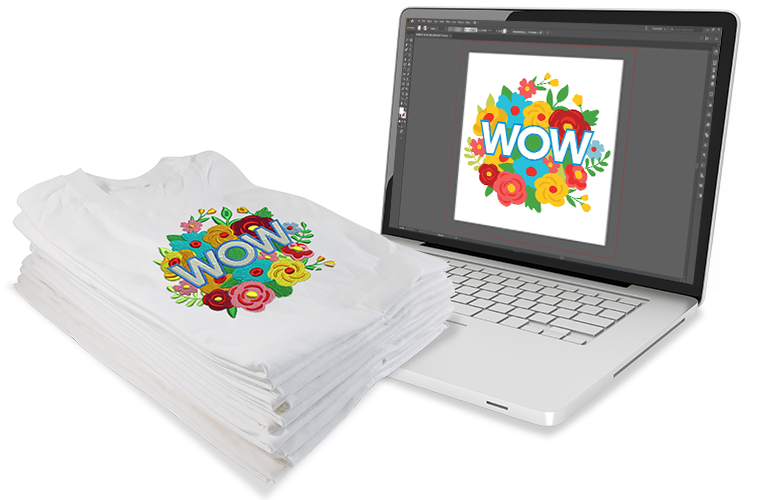Best Digitizing for Embroidery: Improve Your Tasks
Best Digitizing for Embroidery: Improve Your Tasks
Blog Article
Grasping the Needlework Digitizing Process: Your Ultimate Overview
Embroidery digitizing is a precise craft that requires precision and experience to convert elaborate layouts into electronic formats for equipment embroidery. As craftsmens get started on this trip to master the needlework digitizing procedure, an extensive understanding of the essentials sets the foundation for excellence.

Comprehending Needlework Digitizing Fundamentals
Needlework digitizing essentials develop the structure whereupon intricate layouts are equated into machine-readable styles for specific sewing. This first action in the embroidery digitizing process is important for making certain that the last stitched item is a devoted depiction of the original design. Comprehending needlework digitizing fundamentals involves understanding essential concepts such as stitch kinds, stitch instructions, density, padding, and pull compensation.
Stitch types play an important duty in figuring out the aesthetic and textural end result of the embroidered style. By selecting the proper stitch type, whether it be satin, fill, or running stitch, digitizers can attain the wanted impact and boost the overall high quality of the needlework. Furthermore, stitch direction affects the flow and dimension of the style, while thickness identifies the spacing and insurance coverage of the stitches.
In addition, padding stitching supplies stability to the design by protecting the fabric and protecting against distortion throughout the needlework process. Draw payment is an additional crucial consideration to combat the natural propensity of material to agreement when stitched. Understanding these embroidery digitizing essentials is fundamental for producing professional-quality embroidered products.
Selecting the Right Digitizing Software Application
Picking the suitable digitizing software program is an important choice that considerably affects the performance and top quality of the embroidery digitizing process. Digitizing for Embroidery. When selecting the ideal digitizing software program, it is vital to think about factors such as the complexity of styles you prepare to produce, the user-friendliness of the software program, the degree of customer support provided, and the compatibility with your embroidery maker
There are numerous digitizing software program alternatives available out there, ranging from basic programs for novices to advanced software for professional digitizers. Some prominent choices consist of Wilcom EmbroideryStudio, Hatch Embroidery Software Program, and PulseID. These software program bundles offer a vast array of devices and functions to help you produce complex styles with convenience.
Prior to making a choice, it is a good idea to explore the different software options with totally free tests or demos to identify which one finest suits your requirements. In addition, reviewing testimonials and seeking recommendations from experienced digitizers can give useful insights into the toughness and weaknesses of each software (Digitizing for Embroidery). By carefully reviewing your demands and comparing the attributes of different digitizing software, you can make an educated choice that boosts your embroidery digitizing operations
Digitizing Devices and Techniques

Optimizing Design Settings for Needlework
Mastering the intricacies of layout setups is basic in attaining ideal cause the embroidery digitizing procedure, building upon the structure laid by recognizing digitizing devices and methods. When enhancing design settings for needlework, it is necessary to consider factors such as stitch type, thickness, padding, pull compensation, and enrollment. Sew type selection influences the total look of the style, with options like satin, fill, and running stitches offering various appearances and results. Density refers to the use this link spacing and thickness of stitches, influencing the style's coverage and resilience. Appropriate rug sewing offers stability and stops textile distortion, particularly for complicated layouts or on stretchy materials. Draw compensation readjusts for textile stretch throughout stitching, ensuring exact design duplication. Registration setups align various elements of the style accurately, preserving overall style integrity. By fine-tuning these layout settings, embroiderers can enhance the top quality and precision of their stitched creations.

Troubleshooting Common Digitizing Issues
When encountering common digitizing issues throughout the embroidery process, it is necessary to understand the source and apply effective options promptly. One typical trouble is stitch density problems, where stitches might be as well thick, causing the material to tighten, or too thin, leading to spaces in the layout. Adjusting the stitch density setups in the digitizing software can you could check here assist solve this concern.
Another regular obstacle is string breaks throughout the needlework process. This can occur because of different factors such as wrong stress settings, boring needles, or using low-quality thread. Ensuring proper maintenance of the embroidery device, consisting of normal needle adjustments and stress adjustments, can lessen the incident of string breaks.
Moreover, style enrollment mistakes can result in misaligned aspects within the needlework style. Examining the layout alignment in the digitizing software application and making needed changes prior to sewing can help in avoiding this problem. By resolving these common digitizing issues immediately and properly, you can guarantee a smoother embroidery process and premium ended up items.
Final Thought
Finally, understanding the needlework digitizing process needs a strong understanding of the fundamentals, the right choice of software application, and expertise of devices and techniques. Maximizing layout setups and fixing typical digitizing concerns are essential action in making certain premium needlework outcomes. By following these steps diligently, one can attain precision and performance in the digitizing process.
Report this page